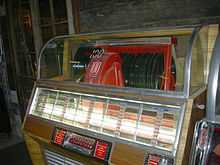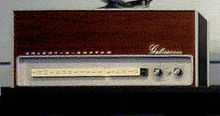Seeburg Corporation
Seeburg was an American design and manufacturing company of automated musical equipment, such as orchestrions, jukeboxes, and vending equipment.
History

Automated musical equipment, such as coin-operated phonographs and orchestrions, were manufactured under the J.P. Seeburg and Company name for most of its early years. Until 1956, the company was family-owned. The company was founded by Justus P. Sjöberg from Gothenburg, Sweden. He moved to the United States after graduating from Chalmers University of Technology and used an Americanized spelling of his surname for the company. In the late 1940s, Seeburg manufactured its popular and distinctive "trashcan-shaped" series of jukeboxes.

When they began to make jukeboxes, the 78 rpm record was standard and only a few selections could be played on one machine. This changed with the Seeburg model M100A, which could play 50 records front and back for a total of 100 selections, an immense variety at the time. In 1950, Seeburg introduced with the first commercial jukebox designed to play the then-new 45 rpm records. They later increased the number of records from 50 to 80, then 100 per machine. The classic M100C is featured during the opening of the "Happy Days" TV series.
Seeburg also manufactured background music players, such as the Seeburg 1000, which used special 9-inch, 16⅔ rpm records.[1]
.jpg)
During the 1960s, Seeburg bought many other companies, including Williams (pinball and other games). In 1979, the Seeburg Corporation was split into two companies, with the "Seeburg Phonograph Division" spun off. This did not survive, as the court closed it in September, 1979. Stern Electronics purchased all of the Seeburg production stock on hand and began producing "Stern/Seeburg" jukeboxes. This only lasted a few years, as Stern/Seeburg also was forced to close. The parts department stock was purchased by Los Angeles-based Jukeboxes Unlimited in September 1980.
A few other attempts were made to use the Seeburg name, but all failed. A final effort was made to save the company in March 1984. This effort was called "The Seeburg Phonograph Company" and was composed of some of the original Seeburg employees. It was the first to produce a CD jukebox. It remained in operation for a few years, and several CD jukeboxes were made at that time. Eventually, the company closed and now nothing remains. The Seeburg name lived again on CD jukeboxes produced in Mexico for a short time.
As of February 2010, a touchscreen digital conversion kit bearing the Seeburg name is being offered.
See also

- Products
- Orchestrion
- Jukebox
- Drum machine (collaboration with Gulbransen home organ in 1960s)
- Related companies
- Gulbransen (a home organ manufacturer that released first transistor organ[2] and earliest transistor rhythm machine;[3] merged with Seeburg in 1960s)
- Kay Musical Instrument Company (once owned by Seeburg during 1965–1967)
- Williams Electronics (once acquired by Seeburg in 1964 (–1973?))
- Stern Electronics (acquired Seeburg in 1979)
References
- ↑ Biro, Nick (July 20, 1959). "Seeburg Background Music Move Part of Diversification Program". Billboard (New York). p. 67.
- ↑ "The Gulbransen Organ". TheatreOrgans.com. May 2006.
- ↑ US patent 3,358,068, Richard H. Campbell, Jr., Gilford, N.H. (Seeburg Corporation), "Musical Instruments", issued 1967-12-12
— related patents filed at the same time were: Automatic Rhythm Device, Automatic Repetitive Rhythm Instrument Timing Circuitry, and sound circuits of Snare Drum Instrument and Cow Bell Instrument.
External links
| Wikimedia Commons has media related to Seeburg Corporation. |
- J.P. Seeburg Company - An Extensive History
- Seeburg jukeboxes
- Jukebox-World online shop for jukebox parts and accessories; forum; serial numbers; classified ads and more
- Seeburg and other jukeboxes and parts
- Photographs and Patent Drawings for Major Seeburg Jukeboxes
- Brief History of the Seeburg Company